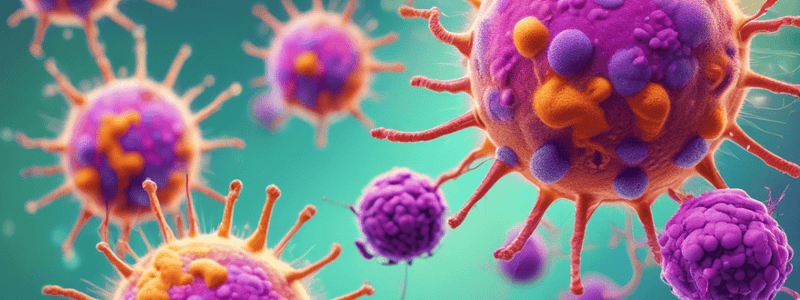Podcast
Questions and Answers
Which immunoglobulin subclass is primarily made in the primary immune response?
Which immunoglobulin subclass is primarily made in the primary immune response?
- IgA
- IgG
- IgE
- IgM (correct)
What type of immune response determines the production of IgA, IgE, and IgG subclasses?
What type of immune response determines the production of IgA, IgE, and IgG subclasses?
- Secondary immune response (correct)
- Primary immune response
- Tertiary immune response
- Quaternary immune response
What is the main function of T cell receptors (TCRs) when recognizing antigens?
What is the main function of T cell receptors (TCRs) when recognizing antigens?
- Recognize linear arrays of amino acids (correct)
- Identify superantigens
- Bind to native antigens
- Interact with B cell receptors
Which term refers to the specific sites on antigens that antibodies or T cell receptors bind to?
Which term refers to the specific sites on antigens that antibodies or T cell receptors bind to?
How are antigens presented to T cells for recognition?
How are antigens presented to T cells for recognition?
What is the root of the term 'polyclonal' in the context of antibodies?
What is the root of the term 'polyclonal' in the context of antibodies?
What structural similarities do the BCR and TCR have?
What structural similarities do the BCR and TCR have?
What distinguishes the BCR from the TCR in terms of solubility?
What distinguishes the BCR from the TCR in terms of solubility?
Why do complex antigens like pathogens give rise to polyclonal responses?
Why do complex antigens like pathogens give rise to polyclonal responses?
Where does the antigen recognition reside in BCR and TCR?
Where does the antigen recognition reside in BCR and TCR?
What aspect of the BCR and TCR structure differs between them?
What aspect of the BCR and TCR structure differs between them?
What percentage of circulating T cells are γδ T cells?
What percentage of circulating T cells are γδ T cells?
Which of the following is NOT a major site for γδ T cells?
Which of the following is NOT a major site for γδ T cells?
How does the antigen recognition by γδ T cells differ from that of αβ T cells?
How does the antigen recognition by γδ T cells differ from that of αβ T cells?
What is the function of γδ T cells?
What is the function of γδ T cells?
Which of the following statements about the TCR genes of γδ T cells is true?
Which of the following statements about the TCR genes of γδ T cells is true?
What is the primary function of the CD3 complex in the T cell receptor complex?
What is the primary function of the CD3 complex in the T cell receptor complex?
Which of the following statements about the structure of the CD3 complex is correct?
Which of the following statements about the structure of the CD3 complex is correct?
What is the primary function of the coreceptors (CD4 and CD8) in the T cell receptor complex?
What is the primary function of the coreceptors (CD4 and CD8) in the T cell receptor complex?
Which of the following statements about T cell antigen recognition is correct?
Which of the following statements about T cell antigen recognition is correct?
What is the role of the randomly generated TCR variants in T cells?
What is the role of the randomly generated TCR variants in T cells?
Which of the following statements about the T cell receptor (TCR) is correct?
Which of the following statements about the T cell receptor (TCR) is correct?
Which of the following statements accurately describes superantigens?
Which of the following statements accurately describes superantigens?
In the context of pathogen invasion, which of the following statements is true?
In the context of pathogen invasion, which of the following statements is true?
Which of the following statements accurately describes the γδ T cell receptor (TCR)?
Which of the following statements accurately describes the γδ T cell receptor (TCR)?
In the context of antigen recognition, which of the following statements is correct?
In the context of antigen recognition, which of the following statements is correct?
Which of the following antigens on a virus or bacterium could potentially be recognized by the T cell receptor (TCR)?
Which of the following antigens on a virus or bacterium could potentially be recognized by the T cell receptor (TCR)?
An immunogen is a substance that can stimulate the immune system to produce an immune response.
An immunogen is a substance that can stimulate the immune system to produce an immune response.
Antigen receptors are specific proteins found on antigen-presenting cells, B cells, and T cells.
Antigen receptors are specific proteins found on antigen-presenting cells, B cells, and T cells.
The main function of B cell receptors is to directly kill invading pathogens.
The main function of B cell receptors is to directly kill invading pathogens.
The term 'immune memory' refers to the ability of the immune system to respond more quickly and effectively upon a second encounter with a pathogen.
The term 'immune memory' refers to the ability of the immune system to respond more quickly and effectively upon a second encounter with a pathogen.
The T cell receptor and B cell receptor have identical structures due to their similar functions.
The T cell receptor and B cell receptor have identical structures due to their similar functions.
Antigen presenting cells play a crucial role in activating T cells by presenting antigens to them.
Antigen presenting cells play a crucial role in activating T cells by presenting antigens to them.
The epitope recognized by the TCR includes only amino acids from the presented peptide and not from the MHC.
The epitope recognized by the TCR includes only amino acids from the presented peptide and not from the MHC.
Superantigens are processed by antigen-presenting cells before binding to TCRs.
Superantigens are processed by antigen-presenting cells before binding to TCRs.
CD4 and CD8 are not involved in ensuring the stability of the immunological synapse formed by TCR binding to peptide/MHC complex.
CD4 and CD8 are not involved in ensuring the stability of the immunological synapse formed by TCR binding to peptide/MHC complex.
T cell activation is initiated by the interaction of variable regions of TCR αβ chains with the MHC only.
T cell activation is initiated by the interaction of variable regions of TCR αβ chains with the MHC only.
Superantigens are effective at high concentrations in activating T-helper cell populations.
Superantigens are effective at high concentrations in activating T-helper cell populations.
Non-classical T cell activation involves superantigens that bind to polymorphic sequences of MHCII β-chain.
Non-classical T cell activation involves superantigens that bind to polymorphic sequences of MHCII β-chain.
γδ T cells account for the majority of circulating T cells.
γδ T cells account for the majority of circulating T cells.
γδ T cells recognize antigens using the same proteins as αβ T cells.
γδ T cells recognize antigens using the same proteins as αβ T cells.
γδ T cells primarily recognize antigens presented in MHC, similar to αβ T cells.
γδ T cells primarily recognize antigens presented in MHC, similar to αβ T cells.
The genes for the γδ TCR are more diverse than those for the αβ TCR.
The genes for the γδ TCR are more diverse than those for the αβ TCR.
γδ T cells are mainly found in epithelial-rich tissues like mucosa.
γδ T cells are mainly found in epithelial-rich tissues like mucosa.
Immunogens are a subset of antigens.
Immunogens are a subset of antigens.
Haptens can elicit an immune response on their own.
Haptens can elicit an immune response on their own.
Soluble antigens cannot enter the body through breaks in the skin or mucous membranes.
Soluble antigens cannot enter the body through breaks in the skin or mucous membranes.
Adjuvants decrease the effectiveness of dendritic cells and macrophages.
Adjuvants decrease the effectiveness of dendritic cells and macrophages.
Benzene is an example of a complex antigen.
Benzene is an example of a complex antigen.
Pattern Recognition Receptors are a type of adaptive antigen receptor.
Pattern Recognition Receptors are a type of adaptive antigen receptor.
NK cells use killer activatory immunoreceptors (KARs) for antigen recognition.
NK cells use killer activatory immunoreceptors (KARs) for antigen recognition.
B cells recognize the 3D conformation of antigens via the T cell receptor (TCR).
B cells recognize the 3D conformation of antigens via the T cell receptor (TCR).
Alum is an example of an adjuvant used in vaccination.
Alum is an example of an adjuvant used in vaccination.
Epitopes are parts of antigens that bind to specific receptors on lymphocytes.
Epitopes are parts of antigens that bind to specific receptors on lymphocytes.
The αβ TCR on T cells can recognize antigens even when not presented by the MHC.
The αβ TCR on T cells can recognize antigens even when not presented by the MHC.
Superantigens made by pathogens activate T cells dependent on antigen specificity.
Superantigens made by pathogens activate T cells dependent on antigen specificity.
Polymorphic responses result in the expansion of many clones of B and T cells recognizing the same antigen.
Polymorphic responses result in the expansion of many clones of B and T cells recognizing the same antigen.
The gd TCR primarily recognizes proteins presented in CD1.
The gd TCR primarily recognizes proteins presented in CD1.
Each T cell produces a TCR with a variable region that allows binding to various antigens.
Each T cell produces a TCR with a variable region that allows binding to various antigens.
CD4 or CD8 are NOT included in the TCR complex.
CD4 or CD8 are NOT included in the TCR complex.
Study Notes
- IgM is produced in the primary immune response, while subclasses like IgA, IgE, and IgG depend on the type of immune response.
- Antigen receptors for B cells are called B cell receptors (BCR), and for T cells, they are T cell receptors (TCR).
- T cells bind linear arrays of approximately 9 amino acids via the TCR, which are processed and presented to T cells by molecules on the surface of antigen-presenting cells.
- Monoclonal antibodies come from a single B cell clone and recognize a single epitope, while polyclonal antibodies come from multiple B cell clones and can recognize a range of epitopes.
- The structure of BCR and TCR both involve repeating units of immunoglobulin folds with constant and variable regions, but they differ in the number of regions and antigen binding sites.
- Complex antigens like pathogens elicit a polyclonal response, activating different T and/or B cell clones in the adaptive immune response.
- TCRs on T cells can only recognize antigens when presented by Major Histocompatibility Complex Molecules (MHC), requiring accessory cells for T cell activation.
Studying That Suits You
Use AI to generate personalized quizzes and flashcards to suit your learning preferences.
Related Documents
Description
Test your knowledge on immunoglobulin subclasses and T cell receptors in the immune response. This quiz covers topics such as the structure of T cell receptors, differences between T and B cell antigens, and superantigens.


